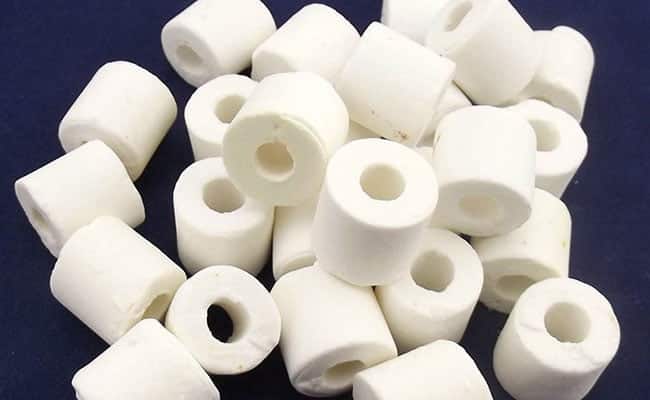3 Ways to Lower Phosphates in Your Aquarium
As any seasoned aquarist will tell you, maintaining the delicate balance of your underwater world is important. One of the key players in this aquatic symphony is phosphates in your aquarium.
It is vital to lower phosphate levels for the health and vitality of your aquatic companions. High phosphate levels can lead to a host of problems — from stubborn algae blooms to stressed-out fish. But worry not! Our mission here is to equip you with the knowledge and tools for effectively managing phosphate in your tank.
We’ll dive deep into phosphate removal techniques and reduction tips, ensuring that you’re well-prepared to create a thriving, crystal-clear aquatic paradise for your finned friends.
Understanding Phosphates in Aquariums
Phosphates, in the context of aquariums, are compounds that contain phosphorus, an essential element. In nature, phosphates serve as nutrients for plants and algae, promoting growth. However, in the confined ecosystem of your aquarium, an excess of these nutrients can spell trouble.
So, why are phosphates problematic? The main issue arises when phosphate levels spike in your tank. Elevated phosphate concentrations can lead to a cascade of problems. Algae, especially the stubborn green varieties, thrive on excess phosphates, turning your aquatic haven into a murky mess. High phosphate levels can also stress out your fish, making them more susceptible to diseases.
Understanding where phosphates come from is the first step toward successfully managing phosphate in your tank. Common sources include:
- Fish food: Many commercial fish foods contain phosphates, which are introduced into the water when fish consume them.
- Fish waste: As your finned friends eat and metabolize, they excrete phosphates into the water.
- Tap water: Depending on your water source, tap water can contain varying phosphate levels.
Testing Phosphate Levels

Testing the phosphate levels in your aquarium is akin to checking your car’s engine oil — it’s a vital part of regular maintenance. Regular testing allows you to monitor phosphate concentrations and catch any undesirable spikes before they wreak havoc. High phosphate levels can lead to algae blooms, fish stress, and a cloudy tank, so keeping them in check is essential.
Testing phosphate levels may sound daunting, but it’s surprisingly straightforward with the right tools. Here’s how to effectively use phosphate test kits:
- Gather your kit: Acquire a high-quality phosphate test kit from a reputable brand. Ensure it’s not expired, as accuracy is key.
- Prepare your sample: Take a water sample from your aquarium. Follow the kit’s instructions for the sample size and method.
- Add reagents: Most kits use reagents that change color based on the phosphate concentration. Carefully add the provided reagents, following the kit’s instructions to the letter.
- Read the results: After allowing the reaction to occur — usually a few minutes — compare the color of your sample to the kit’s color chart. This will indicate the phosphate level in your tank.
- Interpret the results: The color comparison will reveal your phosphate levels — whether they are within the desired range or elevated.
By regularly conducting phosphate tests and recording the results, you’ll be better equipped to make informed decisions on how to lower phosphate levels effectively. It’s a simple yet indispensable practice on your journey to maintaining a pristine and thriving aquarium.
3 Strategies for Lower Phosphate Levels
Now that we’ve gained insight into the significance of phosphate control and the importance of testing, it’s time to roll up our sleeves and get to work. We’ll explore three powerful phosphate removal techniques and phosphate reduction tips that will help you transform your aquarium into a pristine aquatic haven.
These strategies encompass everything from mindful feeding practices to advanced filtration methods, ensuring you have the tools needed to maintain optimal water quality for your beloved aquatic companions. Let’s dive into the details!
1. Reducing Phosphate Input
In our quest to lower phosphate levels and maintain a healthy aquarium, the first strategy we’ll explore is reducing the input of phosphates into your tank. This strategy focuses on proactive measures that prevent excess phosphates from entering your aquatic ecosystem.
Proper Feeding Practices — The foundation of this strategy lies in your fish’s diet. Overfeeding is a common source of elevated phosphate levels. To combat this, follow these steps:
- Offer only the amount of food your fish can consume within a few minutes.
- Observe your fish’s behavior to gauge their appetite, adjusting the portion accordingly.
- Consider feeding your fish smaller meals multiple times a day, simulating their natural grazing habits.
High-Quality Fish Food Selection — Opt for high-quality fish foods with lower phosphate content. Read food labels carefully, and choose products that prioritize balanced nutrition without excessive phosphates.
Controlled Feeding Frequency — Resist the temptation to feed your fish constantly. Controlled feeding frequencies, coupled with appropriate portion sizes, help minimize phosphate buildup.
Avoiding Overfeeding — Overfeeding is a common mistake in fish-keeping. Uneaten food decomposes in the tank, releasing phosphates and contributing to water quality issues. To combat this, scoop out any uneaten food promptly.
By implementing these practices and being mindful of what goes into your aquarium, you can significantly lower phosphate input, ensuring a healthier and more balanced aquatic environment for your beloved fish.
2. Improved Filtration and Maintenance
Another powerful strategy in our quest to lower phosphate levels in your aquarium involves enhancing your filtration system and adopting a rigorous maintenance routine. By improving these aspects of your setup, you can significantly reduce phosphate buildup and promote a healthier aquatic environment.
Upgrading Filtration Systems — Consider upgrading to a more efficient filtration system designed to remove excess nutrients, including phosphates. Options like phosphate-reactive media or specialized phosphate-removing filters can be effective in this regard.
Regular Water Changes — Implementing a regular water change schedule is crucial. Replacing a portion of the water every week or two helps dilute phosphate concentrations and remove accumulated waste. Use a quality dechlorinator to treat tap water before adding it to your tank.
Cleaning Substrate and Decorations — Phosphates can also accumulate in the substrate and on aquarium decorations. Regularly vacuum the substrate to remove detritus and debris, where phosphates can accumulate. Cleaning decorations can also help reduce phosphate levels.
Maintenance Routine Tips — Establishing a consistent maintenance routine is essential for success. Here are some tips:
- Maintain stable water parameters, as sudden fluctuations can stress your fish.
- Regularly inspect and clean your filter media to ensure it functions optimally.
- Keep an eye out for algae growth and address it promptly.
By upgrading your filtration system, performing routine water changes, and practicing diligent maintenance, you’ll be well on your way to effectively lowering phosphate levels in your aquarium. These steps will not only enhance water quality but also create a thriving and harmonious environment for your aquatic companions.
3. Utilizing Phosphate-Reducing Media
Our third and final strategy to effectively lower phosphate levels in your aquarium involves the strategic use of phosphate-reducing media. This approach employs specialized products designed to adsorb and remove excess phosphates from your tank water, ensuring a healthier aquatic ecosystem.
Introduction to Phosphate Adsorption Media — Phosphate adsorption media, also known as phosphate removers, are substances or materials that attract and bind with phosphates, effectively removing them from the water. They’re a valuable tool in achieving and maintaining optimal water quality.
Types of Phosphate-Reducing Media — There are several types of phosphate-reducing media available in the market, including:
- Chemical media: Chemical media are products that typically come in granular or pellet form and are placed in a filter or media reactor. They chemically bind with phosphates.
- Biological media: Certain beneficial bacteria can consume phosphates as part of their natural processes. Bio-media provides a substrate for these bacteria to thrive and remove phosphates.
- Adsorption resins: These resins have a high affinity for phosphates and work by adsorbing them onto their surfaces.
How to Use Phosphate Removers — To effectively utilize phosphate removers, follow these steps:
- Select the appropriate phosphate remover based on your tank’s size and needs.
- Place the chosen media in a filter or reactor as directed by the product’s instructions.
- Monitor phosphate levels regularly to gauge the effectiveness of the media.
- Replace or recharge the media as needed, typically as indicated by the manufacturer or when phosphate levels rise again.
By incorporating phosphate-reducing media into your aquarium setup, you can proactively combat phosphate buildup and contribute to the ongoing effort to lower phosphate levels, fostering a cleaner, healthier environment for your aquatic inhabitants.

Algae Control and Phosphate
Understanding the link between high phosphate levels and algae growth is a game-changer in your mission to lower phosphate levels and maintain a pristine aquarium. Phosphates act as a nutrient for algae, fueling their growth. When phosphate levels are elevated, it’s like turning on a green light for algae to flourish.
Algae, especially the pesky green varieties, thrive when phosphates are abundant in the water. These nutrients serve as a buffet for algae, allowing them to reproduce rapidly and coat your aquarium in an unsightly green film. An excess of phosphates can lead to persistent and frustrating algae outbreaks.
To combat the algae-boosting effects of high phosphate levels, consider the following tips:
- Regular testing: Keep an eye on your phosphate levels and take action if they start to rise.
- Effective filtration: Invest in a good-quality filtration system with phosphate-removing media to help keep phosphate levels in check.
- Proper feeding: Avoid overfeeding, which can lead to excess nutrients and algae growth.
- Moderate lighting: Algae thrive on light. Control the duration and intensity of your aquarium lighting to limit algae growth.
- Regular water changes: Dilute phosphate concentrations through routine water changes.
- Algae eaters: Introduce algae-eating fish or invertebrates, like snails or certain species of shrimp, to help keep algae under control.
By taking these steps, you can break the cycle of high phosphate levels and algae outbreaks, maintaining a beautiful and balanced aquatic environment. Lowering phosphate is not just about aesthetics — it’s about ensuring the health and happiness of your aquatic companions.
Dive into Success — Your Journey to a Pristine Aquarium
In the pursuit of mastering aquarium phosphate control and managing phosphate in your tank, you’ve embarked on a journey to create an aquatic paradise for your finned friends. Throughout this guide, we’ve explored essential phosphate removal techniques and phosphate reduction tips that empower you to maintain a harmonious and thriving aquarium ecosystem.Now, I invite you to take the next step in your journey. For personalized guidance and 1-on-1 coaching, consider reaching out to KaveMan Aquatics.
3 Ways to Lower Phosphates in Your Aquarium
Discover essential tips for fish-keeping enthusiasts. Learn how to effectively lower phosphate levels in your aquarium with phosphate reduction tips.







